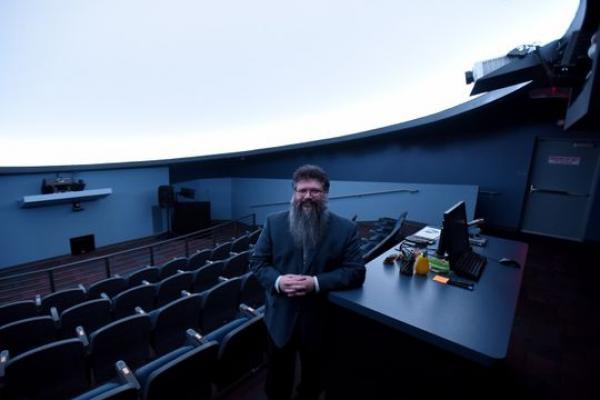Stamatikos Awarded Top Prize in Astrophysics

For the third time in his career, The Ohio State University at Newark Assistant Professor Michael Stamatikos, PhD, has received the prestigious Bruno Rossi Prize from the American Astronomical Society’s High Energy Astrophysics Division (HEAD).

HEAD awards the Bruno Rossi Prize annually for a significant contribution to High Energy Astrophysics, with particular emphasis on recent, original work. In 2021, the recognition went to Francis Halzen and the IceCube Collaboration “for the discovery of a high-energy neutrino flux of astrophysical origin.” The IceCube Collaboration is made up of over 300 researchers, including Stamatikos, from 53 institutions in 12 countries.
This international group of scientists maintains and operates the IceCube Neutrino Observatory located at the South Pole. Made of Antarctic ice, IceCube is buried beneath the surface and extends to a depth of about 2,500 meters. It is instrumented with optical sensors that can detect signals from high-energy neutrinos from outer space. IceCube collaborators address several big questions in physics, like the nature of dark matter and the properties of the neutrino itself. These high-energy astronomical messengers provide information to probe the most violent astrophysical sources: events like exploding stars, gamma-ray bursts (GRBs), and cataclysmic phenomena involving black holes and neutron stars.
On September 22, 2017, IceCube detected a high-energy neutrino signal, which launched an intense global follow-up campaign by terrestrial and orbiting observatories, via a rapid real-time alert system that Stamatikos helped develop based upon his extensive ongoing GRB research with NASA satellite missions Swift and Fermi. The source, TXS 0506+056, was identified by Fermi as quasar four billion light-years away in the constellation of Orion.
“The supermassive black hole at the heart of this quasar powers an active galactic nucleus (AGN) whose spin axis is aligned along Earth’s line of sight. The extreme energy within this beamed jet accelerates particles toward us at near light-speeds. Hence, we call these objects blazars,” explained Stamatikos. The neutrino triggering IceCube had an energy of roughly 300 trillion electron volts (TeV), which is about 50 times more energy achievable at our biggest particle accelerator: The Large Hadron Collider.
He continued, “IceCube and LIGO have demonstrated the viability and discovery potential of opening new observational windows to the cosmos. Neutrinos and gravitational waves have finally arrived to augment the photon, which has been the tireless workhorse of astronomical messengers.”
Stamatikos joined IceCube in 2002, when it was called The Antarctic Muon and Neutrino Detector Array (AMANDA), as Francis Halzen’s graduate student. He spent three weeks at the South Pole as a doctoral student in 2003 to perform routine maintenance on AMANDA and further his understanding of neutrinos and their possible connection to GRBs. These days he is an active member of the IceCube GRB working group. He said, “These efforts have direct tie-ins to the multi-messenger projects that I’m leading at Ohio State, including the campaign to install an autonomous one-meter optical telescope observatory at the John Glenn Astronomy Park [located in Hocking County].”
While serving as a NASA Fellow, Stamatikos was previously recognized as a Bruno Rossi Award recipient in 2007 as a member of the Swift team “for major advances in the scientific understanding of gamma-ray bursts” and in 2011 as a member of the FERMI-LAT team “for enabling, through the development of the Large Area Telescope, new insights into neutron stars, supernova remnants, cosmic rays, binary systems, active galactic nuclei, and GRBs.” The 2011 accolade garnered Stamatikos – then a Postdoctoral Fellow at Ohio State’s Center of Cosmology and AstroParticle Physics (CCAPP), a personalized letter of commendation from former Ohio State President Gordon Gee, in which Gee expressed hope that Stamatikos would bring a third Rossi prize to Ohio State. After a decade, Stamatikos did just that.
“I felt compelled to reach out to Gordon, now President of West Virginia University, so I sent a lighthearted email to let him know, not really expecting a response,” said Stamatikos.
President Gee graciously responded, “I am so very proud of you. And I am very pleased to learn that you were able to bring a third Bruno Rossi prize to the university. Know that I am pleased with all that you are doing to make Ohio State a world-class university.”
IceCube Masterclass
Stamatikos was recently named a 2021 Community Engaged Scholar from Ohio State’s Office of Outreach and Engagement for his myriad public outreach events and science advocacy efforts. In that regard, high school juniors, seniors and their teachers are invited to learn about IceCube directly from Stamatikos in a virtual IceCube Masterclass on April 7. Participants will be able to analyze real IceCube data and converse with researchers all over the world via live webinars and a special live link to researchers at the South Pole. For more information and to register, contact Stamatikos at stamatikos.1@osu.edu.
The Ohio State University at Newark offers an academic environment that’s inclusive of diversity, challenging but supportive with world-renowned professors, and access to Ohio State’s more than 200 majors. It’s where learning comes to life. Research, study abroad and service-learning opportunities prepare students for their careers in ways they never expected.
